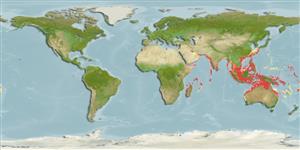Environment: milieu / climate zone / depth range / distribution range
Οικολογία
Θαλασσινό(ά); Υφάλμυρο Υφαλόφιλο(α); εύρος βάθους 12 - 100 m (Ref. 55). Tropical; 33°N - 33°S, 43°E - 178°W
Indo-West Pacific: Persian Gulf and Arabian Sea to Fiji, north to southern Japan, south to Australia. This species has been frequently misidentified as Lutjanus sanguineus (Ref. 55). There are unsubstantiated reports of this species from off East Africa.
Length at first maturity / Μέγεθος / Βάρος / Age
Maturity: Lm 57.6, range 54 - ? cm
Max length : 100.0 cm TL αρσενικό/απροσδιόριστο; (Ref. 55); common length : 50.0 cm TL αρσενικό/απροσδιόριστο; (Ref. 55); μεγ. δημοσιευμένο βάρος: 7.9 kg (Ref. 4699); μεγ. αναφερόμενη ηλικία: 31 έτη (Ref. 46527)
Ραχιαίες άκανθες (συνολικά) : 11; Μαλακές ραχιαίες ακτίνες (συνολικά) : 12 - 14; Εδρικές άκανθες: 3; Μαλακές εδρικές ακτίνες: 8 - 9. This species is distinguished by the following characters: body relatively deep; greatest depth 2.2-2.8 in SL; mouth large, maxilla length about equal to distance between bases of
last dorsal- and anal-fin rays; preopercular notch and knob poorly developed; vomerine tooth patch crescentic or triangular, without a medial posterior extension; gill rakers of first gill arch 4-7 + 12-14 = 18-20 (including rudiments); caudal fin truncate. Colour of back and sides red or red-orange, lighter on lower parts; fins reddish; juveniles with a broad, oblique band of brown or black from upper jaw to beginning of dorsal fin, and a prominent black band across caudal peduncle with a pearly white anterior border, similar to L. timorensis but without the black pectoral-fin axil; young also with a series of narrow reddish horizontal lines (sometimes absent) on sides (Ref. 9821, 90102).
Adults inhabit both coastal and offshore reefs. They tend to be associated with sponge and gorgonian-dominated habitats on the North West Shelf (Ref. 28006), and hard mud areas of the Arafura Sea. In Australia, they frequently form mixed shoals with L. erythropterus. Juveniles tend to inhabit shallow inshore waters and larger fish live in deeper waters (Ref. 27260, 27264). Juveniles also occur in mangrove areas and seagrass beds (Ref. 128523). Feed mainly on fishes, with small amounts of benthic crustaceans, cephalopods and other benthic invertebrates (Ref. 6390). They forage mostly at night (Ref. 6390). Caught mainly with handlines, bottom longlines, and bottom trawls (Ref. 9821). Marketed fresh, dried-salted (Ref. 55) and frozen (Ref. 9987).
Are batch or serial spawners (Ref. 28009).
Allen, G.R., 1985. FAO Species Catalogue. Vol. 6. Snappers of the world. An annotated and illustrated catalogue of lutjanid species known to date. FAO Fish. Synop. 125(6):208 p. Rome: FAO. (Ref. 55)
IUCN Red List Status (Ref. 130435: Version 2024-1)
Threat to humans
Harmless
Human uses
αλιεία: πολύ εμπορικό; αλιεία αναψυχής: ναί; Ενυδρείο: Εμπορικό(ά)
Εργαλεία
Special reports
Download XML
Διαδικτυακές πηγές
Estimates based on models
Preferred temperature (Ref.
123201): 23.8 - 28.6, mean 27.5 °C (based on 745 cells).
Phylogenetic diversity index (Ref.
82804): PD
50 = 0.5000 [Uniqueness, from 0.5 = low to 2.0 = high].
Bayesian length-weight: a=0.01549 (0.01374 - 0.01746), b=2.97 (2.95 - 2.99), in cm total length, based on LWR estimates for this species (Ref.
93245).
Τροφικό Επίπεδο (Ref.
69278): 4.5 ±0.5 se; based on diet studies.
Generation time: 6.1 (4.2 - 8.7) years. Estimated as median ln(3)/K based on 24
growth studies.
Ελαστικότητα (Ref.
120179): Χαμηλό, ελάχιστος χρόνος για διπλασιασμό πληθυσμού 4,5 - 14 έτη (K=0.12-0.18; tmax=12; Fec=5,000,000).
Prior r = 0.17, 95% CL = 0.11 - 0.25, Based on 1 full stock assessment.
Fishing Vulnerability (Ref.
59153): High vulnerability (60 of 100).
Climate Vulnerability (Ref.
125649): Very high vulnerability (88 of 100).
Nutrients (Ref.
124155): Calcium = 18.9 [11.4, 28.8] mg/100g; Iron = 0.279 [0.178, 0.460] mg/100g; Protein = 18.8 [17.3, 20.2] %; Omega3 = 0.134 [0.092, 0.196] g/100g; Selenium = 69.5 [40.5, 114.1] μg/100g; VitaminA = 179 [31, 733] μg/100g; Zinc = 0.374 [0.285, 0.518] mg/100g (wet weight); based on
nutrient studies.
